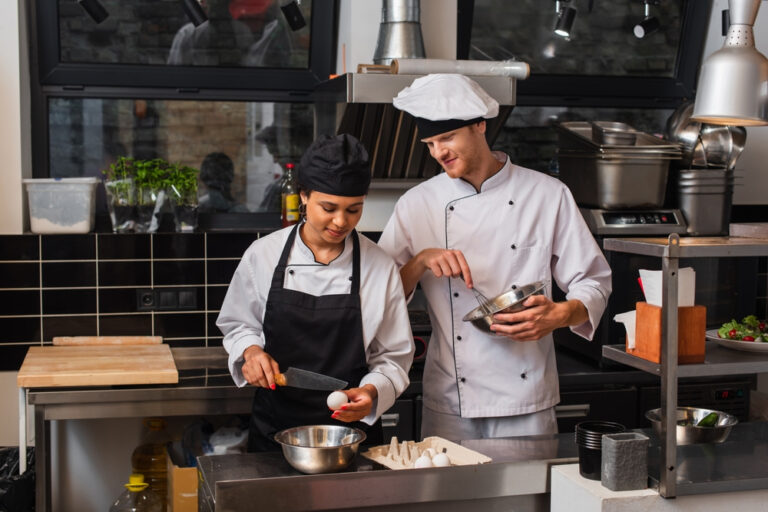A Brief History Of The Chef Uniforms

Chef uniforms are more than just clothing; they tell a story of tradition, function, and identity in the world of cooking. These unique outfits, worn by chefs in kitchens everywhere, have a history that stretches back centuries. They’re not just about looking good; they serve essential purposes like keeping chefs safe and clean.
In this journey through time, we’ll explore how chef uniforms have changed from simple aprons to the iconic white jackets and toques we see today. We’ll also peek into modern trends, where some chefs add a dash of creativity to their attire. Chef uniforms, simple yet significant, are a cornerstone of the culinary world.
Early History
Like the one we see today, the chef’s uniform started with a famous chef named Marie-Antoine Carême in 1822. He drew a picture called “Le Maitre d’Hotel Francais,” showing two chefs wearing white hats, double-breasted coats, and aprons tied around their waists.
But it wasn’t until 1878 that this uniform became popular. A company called Angelica Uniform Group started making lots of these outfits so chefs everywhere could wear them. Auguste Escoffier, who made the Brigade de Cuisine and is our school’s namesake, was the first to make this uniform a rule. All the chefs in the restaurants he ran in London had to wear it.
Even though the chef’s uniform has changed a bit over time, it still resembles Carême’s drawing. Today, it has a white hat, a double-breasted coat, pants, and an apron around the waist. Each piece of clothing means something special and helps the chef do their job well.
The Development of the Modern Chef Uniform

In the 19th century, the chef’s uniform started to look more like what we know today. It was a time of change and improvement.
First, the double-breasted white jacket showed up. It was like an intelligent coat that kept chefs looking tidy. Then came the toque, a fancy name for the chef’s hat. These things weren’t just for show. They had jobs to do.
The jacket kept chefs clean, and the hat was tall to show who was in charge. They also had aprons to cover up and protect their clothes. This new uniform was all about being helpful and clean.
People liked it, quickly became the standard uniform for chefs worldwide. So, in the 19th century, the modern chef’s uniform was born, and it’s still with us today, doing its job in kitchens everywhere.
Modern Trends in Chef Uniforms

Nowadays, some chefs are giving their uniforms a makeover. They’re getting creative!
Instead of just plain white jackets, some chefs are choosing colorful ones. Picture bright blues, reds, or even funky patterns. It’s a way to express their personality and style while they cook.
And the chef hats? Well, they’re only sometimes the tall, traditional ones. Some chefs wear hats with fun designs or unique shapes. They say, “I’m a chef, and I’ve got my style.”But even with these remarkable changes, many chefs still stick with the classic white jacket and tall hat. It’s like a nod to tradition, showing respect for the history of their craft.
So, in the modern world of cooking, chef uniforms have a bit more flair and variety, but the old-school look is still a favorite for many chefs.
Traditional Chef Uniform
The classic chef’s outfit is like a timeless recipe. It has mostly stayed the same over the years and works just right.
Chef's Hat
The tall white hat is like a symbol of a chef’s wisdom. It also keeps hair from falling into the food. You can spot a chef from a mile away with this hat.
Chef's Jacket
The white, double-breasted jacket is more than just stylish. It’s designed to keep chefs clean and cool. The thick fabric protects them from hot stuff in the kitchen.
Chef's Pants
These pants are comfortable and loose. They let chefs move around quickly and stay in the way while cooking delicious dishes.
Apron
The apron is like a superhero cape for chefs. It shields their clothes from spills and splatters to look sharp all day.
These traditional chef outfits are like a uniform of pride. They show that the person wearing them is a skilled chef, ready to whip up something unique in the kitchen.
Conclusion
With their rich history and iconic design, chef uniforms play a vital role in the culinary world. From their humble beginnings as practical attire, these uniforms have evolved into symbols of professionalism, expertise, and cleanliness in the kitchen. The traditional ensemble, consisting of the tall chef’s hat, double-breasted jacket, comfortable pants, and trusty apron, represents a chef’s dedication to their craft. It’s more than just clothing; it’s a badge of honor.
Recently, some chefs have added a touch of personal flair to their uniforms with colorful jackets and unique hats. Yet, the classic white attire remains a favorite, paying homage to culinary traditions. In kitchens around the globe, chef uniforms are more than garments; they are a statement of commitment, skill, and passion, embodying the essence of the culinary arts.
